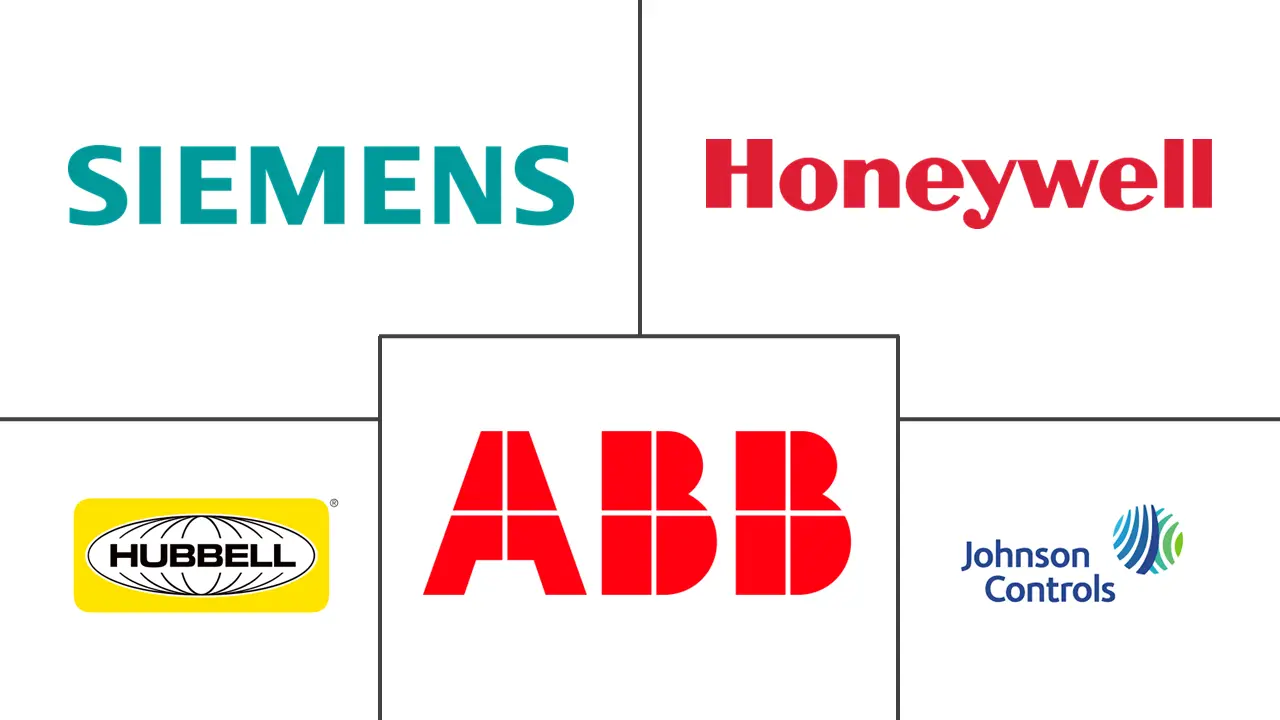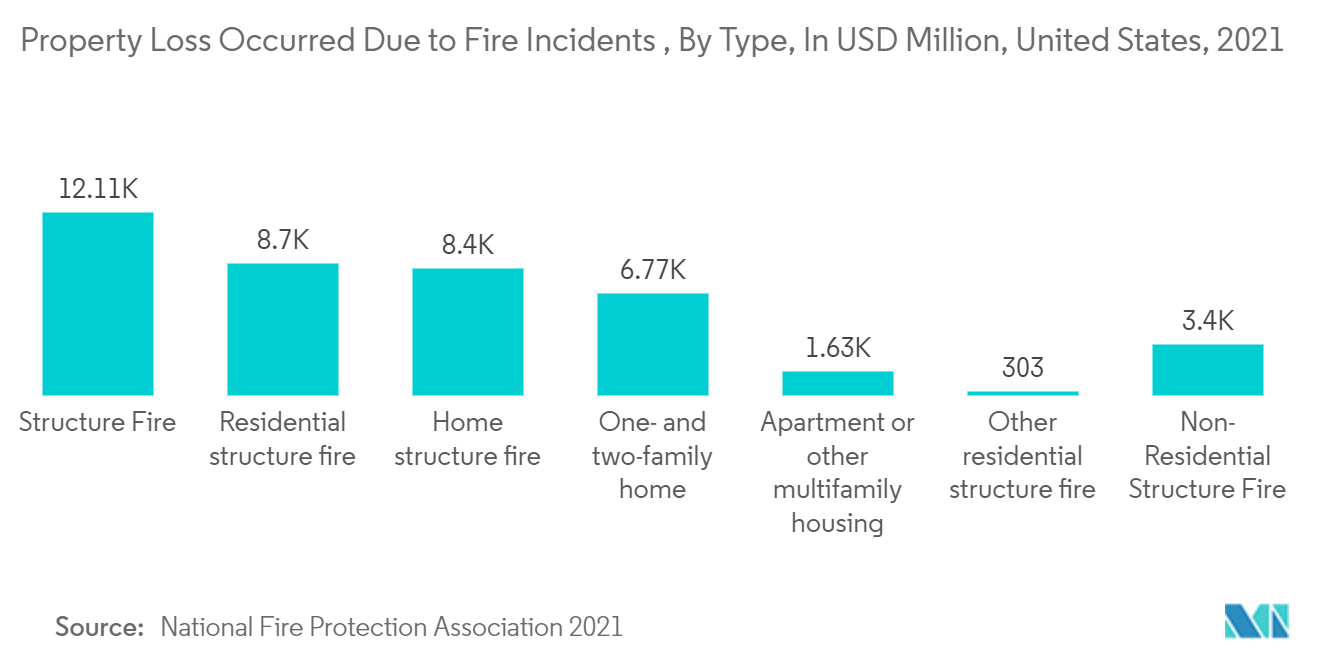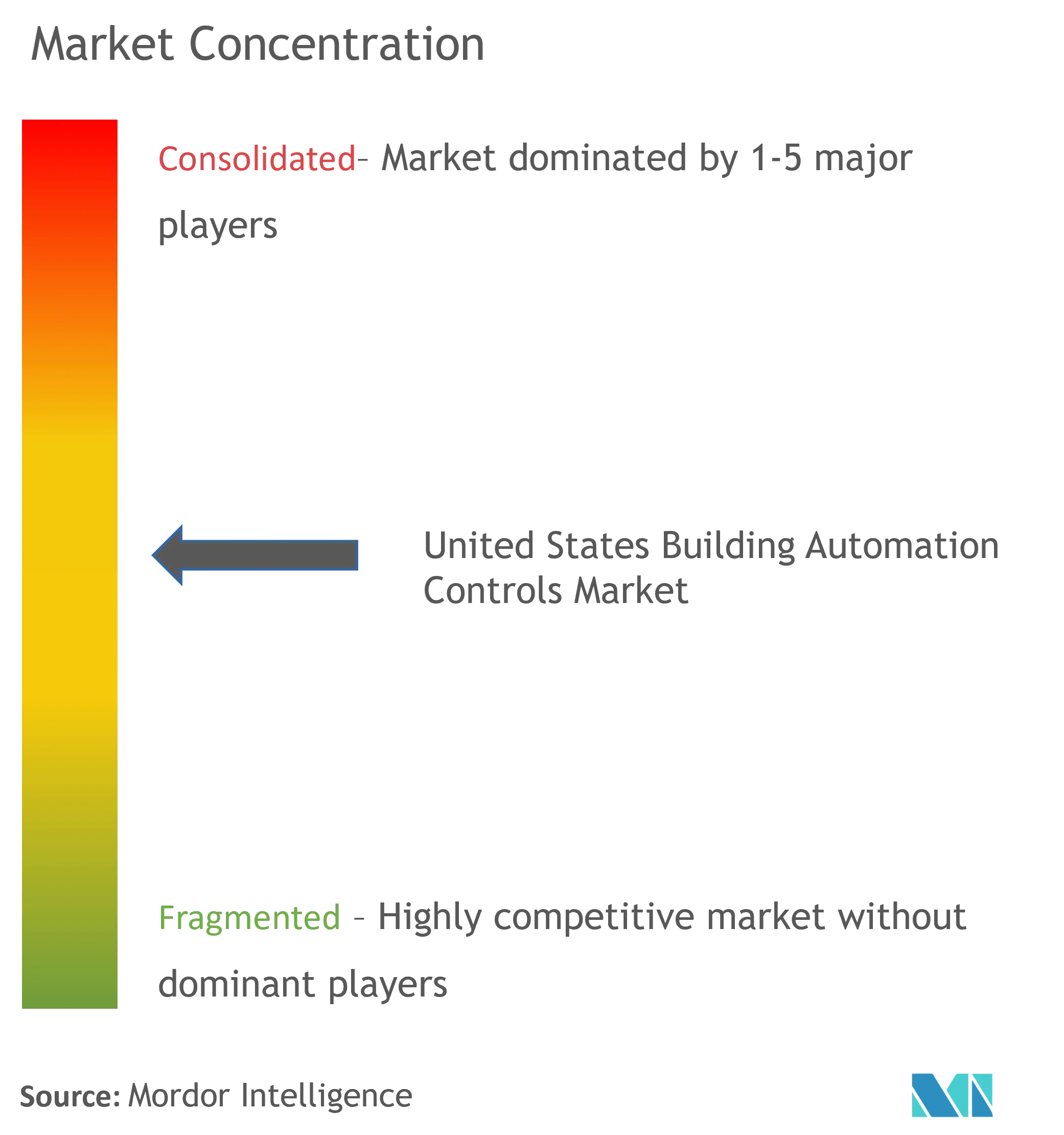US Building Automation Controls Market Size

| Study Period | 2019 - 2029 |
| Base Year For Estimation | 2023 |
| Forecast Data Period | 2024 - 2029 |
| Historical Data Period | 2019 - 2022 |
| CAGR | 6.50 % |
| Market Concentration | Medium |
Major Players
*Disclaimer: Major Players sorted in no particular order |
US Building Automation Controls Market Analysis
The united states building automation control systems market are expected to register a CAGR of 6.5 % over the forecast period (2022 - 2027). Building automation systems use information flow to a monitoring point to connect and integrate various facility technologies, such as HVAC, security, surveillance, and lighting. Building automation systems are increasingly being adopted in the business sector due to the need for energy management and the increasing focus on reducing utility costs. The majority of commercial structures in the US have these solutions.
- According to the New York State Energy Research and Development Authority, enabling real-time energy management systems and smart technologies could reduce costs by an average of 15% and increase the bottom line by creating an environment that encourages employee productivity and reduces energy waste, according to the New York State Energy Research and Development Authority (NYSERDA).
- Building managers and security experts are becoming more aware of the risk of smart building security as buildings become more integrated with IT and networking technology. Institutions in the financial services sector and other sectors should place a priority on smart building security since they are potentially lucrative targets for hackers. Because of these changes, the need for intelligent security system solutions will increase.
- Moreover, smart building IoT is gaining popularity in the commercial spaces as it provides user-friendly automation and application of intelligence for tasks, such as timer-controlled heating to an entire building by automatically regulating HVAC systems. IoT facility management service provides efficient physical security for a smart building by using cameras, movement detectors, and digital identification factors, such as biometrics identification systems.
- According to US facility managers, there is also a strong interest in upgrades and innovative building environments. Yet respondent input shows a major gap in the technologies currently deployed in the buildings. More than half of those surveyed says that the buildings they manage do not have proper air quality solutions (57%), integrated lighting that improves occupant productivity (66%), contactless building entry (67%), or an app that provides real-time information on building health (73%). Such a factor is expected to encourage the adoption of automation solutions post-pandemic.
- Despite the benefits that smart buildings offer, the building automation systems industry has always faced a tremendous challenge due to the way manufacturers deploy and install their systems. Significant building control systems are closed protocols that do not allow third-party systems to be installed in the ecosystems. Commercial building owners are challenged when it comes to choosing a sole manufacturer to be tied down to, as this lack of flexibility in installed systems could lead to high routine maintenance costs and delayed service.
US Building Automation Controls Market Trends
This section covers the major market trends shaping the US Building Automation Controls Market according to our research experts:
Fire Protection Systems are one of the Factor Driving the Market
- Integrating fire and safety systems with automated buildings is essential for preventing or minimizing loss during a fire threat. A fire safety system provides a high level of coordination, which is required between the active fire system, building-wide communications, and interactive smoke control systems in case of a fire. This method reduces the quantity of damage that a fire might inflict.
- According to the national fire protection association 2021 report, in 2020, local fire departments responded to an estimated 1.4 million fires in the united states. These fires resulted in the deaths of 3,500 civilians and the injury of 15,200 civilians. Property damage was projected to be worth USD 21.9 billion. In 2020, a fire department in the united states responded to a fire every 23 seconds on average. Every 89 seconds, a home structure fire was reported, every three hours and 24 minutes, a home fire death was reported, and every 46 minutes, a home fire injury was reported.
- With the improvements in the sensors' capabilities and communication channel technology, IoT devices present in industries and residential spaces have made the adoption of new-tech solutions possible. Therefore, the market is experiencing the demand for fire safety systems that can integrate with the new as well as legacy systems.
- Owing to safety policies and regulations applicable to the industry, despite market maturity, the industry continues to introduce new product offerings that have contributed to product turnover and attracted new demand. In many cities, it is a statutory requirement to carry out fire evacuation drills at least twice a year in all residential and commercial spaces. Further, the awareness toward the adoption of equipment to meet the safety standards, regulations, and fire safety systems is demanded in several process industries, such as oil and gas, power generation, water and wastewater, food manufacturing, metal and mining, paper and pulp, and textile manufacturing and processing.
- In December 2021, Texas Fire Alarm(TFA), a full-service fire protection provider, was acquired by the National Fire & Safety, end-to-end fire protection and life safety solutions platform and a portfolio business of Highview Capital. TFA specializes in warehouse/distribution, industrial, commercial, and multi-family fire alarm, fire sprinkler, extinguisher, and kitchen hood system service. TFA's staff includes NICET-certified engineers and highly qualified technicians. TFA's full-service fire protection services include TFA's central monitoring station's 24-hour emergency monitoring. Such acquisitions will enable the company to develop the products according to the requirements of customers and increase the market share in the studies region.

US Building Automation Controls Industry Overview
The United States Building Automation market is moderately consolidated, with the presence of a few major companies. The companies are continuously investing in making strategic partnerships and product developments to gain more market share. Some of the recent developments in the market are:
- January 2022- Stay-Lite Lighting, nationwide lighting and electrical maintenance service provider was acquired by Orion Energy Systems, Inc., a provider of energy-efficient LED lighting, control, and IoT systems, including turnkey project implementation, program management, and system maintenance. The acquisition enables Orion Maintenance Services to develop faster, which provides lighting and electrical services to customers.
- November 2021 - AI Fire has acquired BCI Technologies. BCI Technologies installs, repairs, and services specialized security systems for businesses and commercial facilities. The Academy Fireteam of AI Fire will open its first district office in Dallas, Texas, due to the acquisition.
US Building Automation Controls Market Leaders
-
Honeywell International, Inc
-
Siemens AG
-
ABB Limited
-
Johnson Controls International
-
Hubell
*Disclaimer: Major Players sorted in no particular order

US Building Automation Controls Market News
December 2021 - Cross-Fire & Security Co., Inc., a full-service life safety company specializing in the design, engineering, installation, maintenance, monitoring, and servicing of state-of-the-art fire and life safety systems, has announced the acquisition of NISCO, Inc., which is made up of Northeast Integrated Systems and Northeast Fire Systems, Inc (collectively "NISCO"), a provider of fire alarm and life safety solutions throughout the Northeastern United States.
August 2021- The California Energy Commission (CEC) approved the 2022 Building Energy Efficiency Standards (Energy Code) for new and refurbished structures, which will enable the state meet its public health, climate, and renewable energy goals. The CEC, as the state's major energy policy and planning agency, develops regulations every three years to boost building energy efficiency and reduce carbon emissions. Homes and businesses consume approximately 70% of California's electricity and produce a quarter of the state's greenhouse gas emissions.
US Building Automation Controls Market Report - Table of Contents
1. INTRODUCTION
- 1.1 Study Assumptions and Market Definition
- 1.2 Scope of the Study
2. RESEARCH METHODOLOGY
3. EXECUTIVE SUMMARY
4. MARKET INSIGHTS
- 4.1 Market Overview
-
4.2 Industry Attractiveness - Porter's Five Forces Analysis
- 4.2.1 Bargaining Power Of Suppliers
- 4.2.2 Bargaining Power Of Buyers
- 4.2.3 Threat Of New Entrants
- 4.2.4 Threat Of Substitute Products
- 4.2.5 Intensity Of Competitive Rivalry
- 4.3 Assessment Of The Impact Of Covid-19 On The Industry
5. MARKET DYNAMICS
-
5.1 Market Drivers
- 5.1.1 Favorable local regulations driving adoption of security & fire protection systems
- 5.1.2 Rising demand for energy efficient buildings in the region
- 5.1.3 Technological advancements in the field of IoT & wireless infrastructure
-
5.2 Market Challenges
- 5.2.1 Absence of Technology Alignment and High Acquisition and Implementation Costs
6. TECHNOLOGY SNAPSHOT
- 6.1 Analysis of major communication protocols (KNX, NON-KNX)
- 6.2 Major advancements in the field of Building Automation and Control Systems
- 6.3 Analysis of new & retrofit installations
7. MARKET SEGMENTATION
-
7.1 By Type
- 7.1.1 Lighting Controls
- 7.1.2 HVAC Systems
- 7.1.3 Security and Access Control
- 7.1.4 Fire Protection Systems
- 7.1.5 Software(BEMS)
- 7.1.6 Services(Professional)
-
7.2 By End User
- 7.2.1 Residential
- 7.2.2 Commercial
- 7.2.3 Industrial
8. COMPETITIVE LANDSCAPE
-
8.1 Company Profiles
- 8.1.1 Honeywell International, Inc
- 8.1.2 Siemens AG
- 8.1.3 ABB Limited
- 8.1.4 Johnson Controls International
- 8.1.5 Hubell
- 8.1.6 Delta Controls
- 8.1.7 Robert Bosch
- 8.1.8 Schneider Electric
- 8.1.9 United Technologies Corporation
- 8.1.10 Lutron Electronics
- *List Not Exhaustive
9. INVESTMENT ANALYSIS
10. FUTURE OF THE MARKET
** Subject To AvailablityUS Building Automation Controls Industry Segmentation
Building automation is the centralized control of a building's heating, ventilation, air conditioning, lighting, and other systems. It is controlled by a building management system (BMS) or a building automation system (BAS). Building automation aims to improve occupant comfort and the efficiency of building systems and reduce energy consumption and operating costs.
The scope of the study focuses on the market analysis of building automation control products sold across the United states and market sizing encompasses the revenue generated through building automation control products sold by various market players. The study also tracks the key market parameters, underlying growth influencers, and major vendors operating in the industry, which supports the market estimations and growth rates over the forecast period. the study further analyzes the overall impact of Covid-19 on the ecosystem.
| By Type | Lighting Controls |
| HVAC Systems | |
| Security and Access Control | |
| Fire Protection Systems | |
| Software(BEMS) | |
| Services(Professional) | |
| By End User | Residential |
| Commercial | |
| Industrial |
US Building Automation Controls Market Research FAQs
What is the current United States Building Automation Controls Market size?
The United States Building Automation Controls Market is projected to register a CAGR of 6.5% during the forecast period (2024-2029)
Who are the key players in United States Building Automation Controls Market?
Honeywell International, Inc, Siemens AG, ABB Limited , Johnson Controls International and Hubell are the major companies operating in the United States Building Automation Controls Market.
What years does this United States Building Automation Controls Market cover?
The report covers the United States Building Automation Controls Market historical market size for years: 2019, 2020, 2021, 2022 and 2023. The report also forecasts the United States Building Automation Controls Market size for years: 2024, 2025, 2026, 2027, 2028 and 2029.
United States Building Automation Controls Industry Report
Statistics for the 2024 United States Building Automation Controls market share, size and revenue growth rate, created by Mordor Intelligence™ Industry Reports. United States Building Automation Controls analysis includes a market forecast outlook to 2029 and historical overview. Get a sample of this industry analysis as a free report PDF download.



